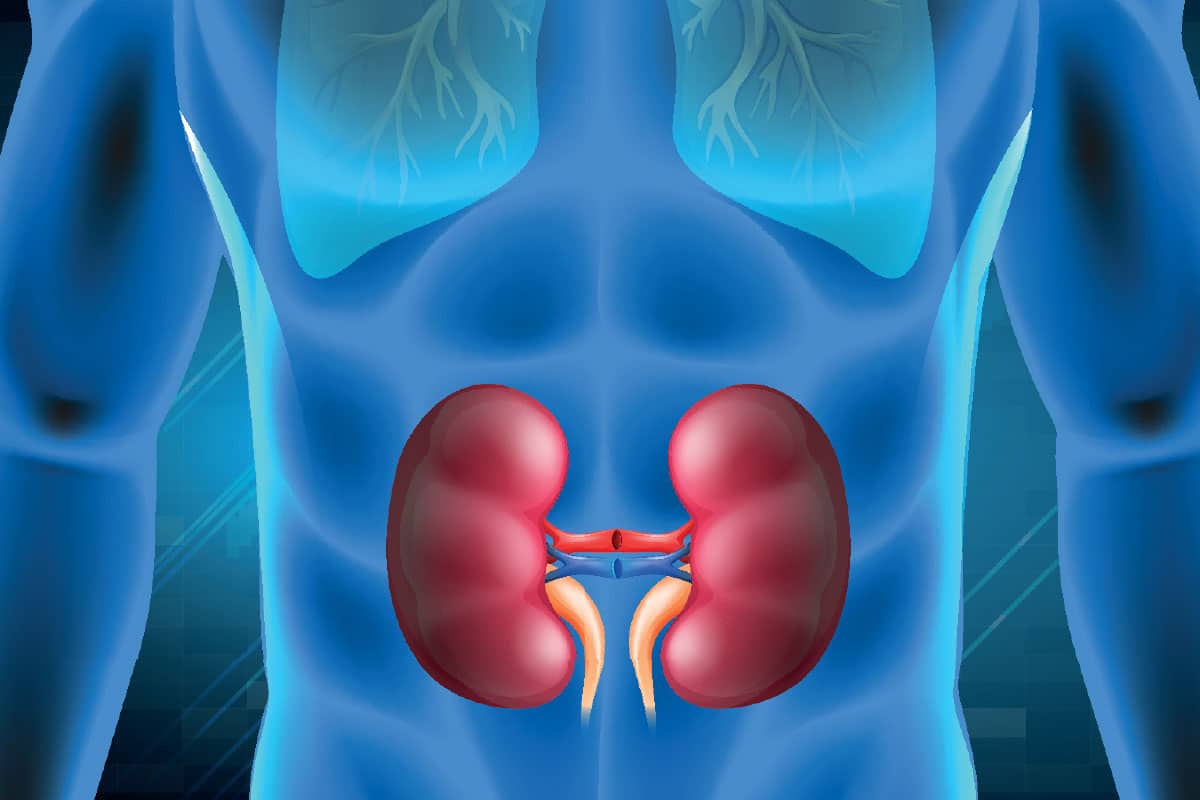
Diabetes is responsible for a wide range of diseases, the severity of which varies according to the age and risk factors of each individual. But what are the kidney diseases that most affect people with diabetes? What signs help to identify them in their early stages? And how can their progression be slowed down? Let’s take a look at diabetic nephropathy and its most worrying complication: chronic renal failure.
Diabetic nephropathy
The disease
The kidney plays an essential role in the functioning of the urinary system. With the urine, it eliminates products such as glucose, potassium, sodium and a protein made up of a large number of amino acids: albumin. It also filters the blood to remove waste products that are toxic to the body. These processes involve small vessels that deteriorate when blood sugar levels are abnormally high. In other words, diabetes tends to damage the walls of the kidneys and prevents them from removing waste products from the body. Diabetic nephropathy is a term used to describe a dysfunction of this process in a person with type 1 or type 2 diabetes. This condition, also known as chronic kidney disease, often develops after 20 years of diabetes.
Its symptoms
Diabetic nephropathy can be difficult to diagnose because in most people it begins asymptomatically. Later, many signs indicate the presence of the disease, such as:
- itching all over the body,
- swelling in the hands, eyelids or feet,
- blood in the urine,
- feeling weak and tired,
- lack of appetite,
- high blood pressure,
- or vomiting.
Its complications
If not diagnosed and treated in time, nephropathy leads to a total loss of kidney function, resulting in end-stage renal failure. It also greatly increases the risk of developing cardiovascular disease. This risk is increased by factors such as age, overweight, sedentary lifestyle, smoking and the presence of proliferative retinopathy.
Its diagnosis
Nephropathy should be monitored acutely in people with diabetes. Depending on the age and severity of the diabetes, the doctor will prescribe screening every 5 years, every 2 years or even every year. This consists of urine and blood tests to measure the albumin level in the body. This protein is one of the elements eliminated, in principle, by the urine after its filtration by the kidneys. It is responsible for transporting hormones and free fatty acids through the body. An abnormally high concentration of albumin in the urine is a condition called albuminuria. A high albumin content indicates an abnormality in the excretory function of the kidneys. The stage of the disease (between 1 and 5) is identified by the doctor on the basis of the albumin concentration in the urine.
Its treatment
The appropriate treatment for diabetic nephropathy varies according to the stage of the disease. The progression of the disease can be slowed down by:
- taking medication,
- a diet low in certain minerals and limited in protein,
- and tight control of blood pressure and blood sugar levels.
In some cases, dialysis is unavoidable. This is a medical technique in which a machine temporarily acts as an artificial kidney. In other words, it takes over from the organs to purify the blood. The operation takes about four hours and is usually repeated several times a week. It takes place under medical supervision, in the presence of a nurse.
Kidney failure
The disease
Kidney failure is one of the main complications of diabetic nephropathy.
Chronic renal failure can have several causes. Among them, diabetes and then high blood pressure are at the top of the list. As a matter of fact, the hyperglycemia inherent in diabetes damages the glomeruli – the clusters of vessels that are essential for blood filtration. High blood pressure leads to narrowing of the arteries leading to the organs (such as the kidneys and heart) and thus to failures in their oxygen supply.
Its symptoms
At first, chronic kidney disease may not cause any symptoms. However, in diabetics, high blood pressure or pre-hypertension may be a warning sign of the disease. Other warning signs include:
- drowsiness, difficulty in breathing or great fatigue during exercise (these manifestations are linked to anemia),
- heart rhythm problems or even cardiac arrest (because the blood becomes too rich in potassium),
- nausea or vomiting (caused by the accumulation of uric acid, creatinine, and urea in the metabolism),
- oedema (due to excess water in the tissues),
- bone fragility (when the blood suffers from an excess of phosphorus),
- muscle cramps in the legs,
- generalized itching,
- frequent urination,
- loss of weight or appetite,
- cloudy urine,
- and insomnia.
Its complications
Kidney failure causes a host of complications. For example, it leads to severe anemia, as the kidneys no longer produce enough erythropoietin, a hormone that stimulates the production of red blood cells in the bone marrow. Oxygen cannot be transported by the hemoglobin contained in these cells, the blood becomes more viscous, and the tissues are no longer supplied with oxygen. This leads to a drop in vitality and severe fatigue in the anemic patient. In addition, like diabetic nephropathy, kidney failure increases the risk of developing cardiovascular diseases such as atherosclerosis, angina pectoris, stroke, or myocardial infarction. More generally, this condition leads to irreversible destruction of the kidneys, and therefore death.
Its diagnosis
To detect kidney failure, the amount of creatinine and urea in the blood must be assessed. This measurement also makes it possible to determine the stage of the disease.
Its treatment
Faced with a diagnosis of renal failure, the nephrologist adapts their treatment strategy to the patient. Their objective is not to completely cure the disease (which is impossible), but to reduce its negative consequences on the patient’s health. Depending on the stage of the disease and its concomitant risk factors, the specialist may prescribe medication and dietary changes. If the disease continues to progress despite these treatments, dialysis becomes necessary. This may be:
- peritoneal, i.e., based on the insertion (under anesthesia) of a catheter to introduce a dialysis fluid into the body,
- or extracorporeal; using a technique of filtering blood through an artificial membrane for several hours a week (this is called hemodialysis).
Sometimes a transplant is necessary to improve the patient’s well-being and life expectancy. This is preferably done with an organ from a living donor. This practice is currently insufficiently developed in Europe. The lack of donors prevents many patients from accessing this treatment, which is effective in the most advanced stages of the disease. According to recent statistics, Spain is the European country with the highest number of kidney transplants performed in 2020. However, the Covid-19 pandemic has greatly affected this field of medicine and most countries (even Spain) are experiencing a severe decrease in the number of transplants performed each year. Across the continent, tens of thousands of people are waiting for an available transplant.
Sources:
- https://www.diabetes.org.uk/guide-to-diabetes/complications/kidneys_nephropathy#:~:text=Diabetic%20nephropathy%20is%20the%20name,need%20treatment%20for%20diabetic%20nephropathy
- https://cdn.shopify.com/s/files/1/1922/6045/files/Diabetes_and_Kidney_Disease_web.pdf?v=1613555917&_gl=1*1ibrz5c*_ga*MTI1NjA2NTIxMi4xNjQ4Mjg1NjA1*_ga_J1HFNSGEX6*MTY0ODQ3NDYxNy4yLjEuMTY0ODQ3NDY3OS42MA
- https://www.diabetes.co.uk/diabetes-complications/kidney-disease.html
- https://academic.oup.com/ndt/article/27/6/2269/1941267
- https://www.uhcw.nhs.uk/download/clientfiles/files/Patient%2520Information%2520Leaflets/Medicine/Renal/118394_Diabetic_Nephropathy_(395)_-_nov18.pdf&ved=2ahUKEwij9t7y-Oj2AhUH3IUKHbglDsYQFnoECA8QAQ&usg=AOvVaw1Cmakucu7ClPc42hje1ST8
- https://www.uhcw.nhs.uk/download/clientfiles/files/Patient%2520Information%2520Leaflets/Medicine/Renal/118394_Diabetic_Nephropathy_(395)_-_nov18.pdf&ved=2ahUKEwij9t7y-Oj2AhUH3IUKHbglDsYQFnoECA8QAQ&usg=AOvVaw1Cmakucu7ClPc42hje1ST8
- https://www.ajkd.org/article/S0272-6386(19)30776-0/fulltext
- https://www.ajkd.org/article/S0272-6386(15)01162-2/fulltext
- https://www.frontiersin.org/articles/10.3389/fcell.2019.00314/full
- https://bmcnephrol.biomedcentral.com/articles/10.1186/s12882-019-1522-8
- https://www.statista.com/statistics/537935/kidney-transplant-rate-in-europe/
Our latest publications
Want to learn more about topics related to blood sugar management?
Here are our most recent blog posts!



